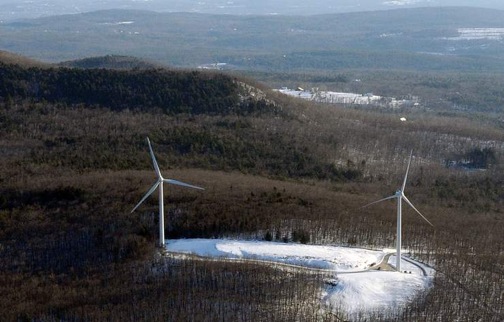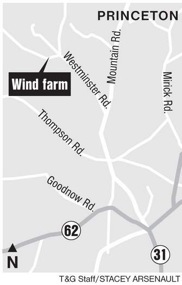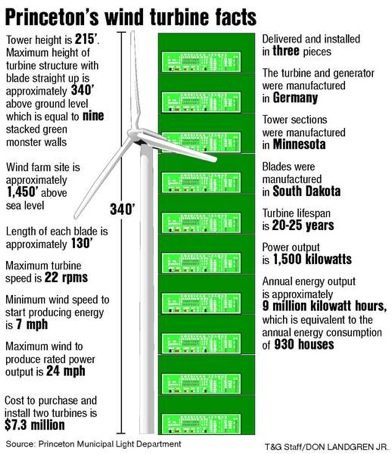
Sunday, December 13, 2009
Wind for sale
PRINCETON STARTS TURBINES SPINNING

Two 1.5-megawatt wind turbines have been built near Westminster Road in Princeton and are now producing power. (T&G Staff / RICK CINCLAIR)
By Paula J. Owen CORRESPONDENT
PRINCETON — During testing and commissioning the last few weeks, the two 1.5-megawatt wind turbines off Westminster Road already are producing enough power to provide electricity for 130 homes, and at full capacity will supply electricity to 40 percent of residents and businesses in town.
With almost half of Princeton's land protected from development by the state, residents are more aware of environmental issues and demand a large part of their power come from a renewable resource, says Jonathan V. Fitch, manager of Princeton Municipal Light Department.
“It goes beyond the Wachusett Mountain State Reservation,” he said. “I think it is about every stream and pond — 40 percent of the town is essentially undeveloped, protected forest and wetlands.”

The turbines replaced eight smaller windmills that were installed in the 1980s and decommissioned in 2004. The $7.3 million project is a joint effort of Massachusetts Municipal Wholesale Electric Co., also known as MMWEC, and the Princeton Municipal Light Department.
With another 15 percent of the town's power coming from hydroelectric plants, Princeton will be the only municipality in the area getting more than half of its power generated from renewable resources, Mr. Fitch said.
“I don't know of any other municipality doing that,” he said. “Residents told us that acquiring a large amount of renewable resources was important to them. With both combined, 55 percent is significant and fairly high compared to other utilities. I think it should set an example for the rest.”
The 210-foot-tall towers were fully erected Oct. 30. Testing began Nov. 9.

“Since then, most of the work has been programming the turbines to work in our environment,” Mr. Fitch said. “Each site is unique. The wind source is different, the structures are slightly different and the turbines act differently on each foundation. Certain characteristics need to be monitored and programmed for and that's what we're dealing with right now.”
The turbines are turned off about 50 percent of the time during testing, he said, and generate about half the amount of power they will when operating at capacity.
When they are fully operational in the next week or two, he said, they will run nonstop, and — depending on the wind — generate 9 million kilowatt hours of power annually, equating to $720,000 worth of electricity a year.
A commissioning ceremony scheduled for this weekend was postponed until spring because of the weather and conditions at the site. Mr. Fitch said residents will be able to take a look inside the base of the towers when the event is rescheduled.
“I think people will get a kick out of looking inside and seeing how simple it is below,” he said. “It is not as complicated as it looks. There is just a circuit with a panel to turn it on and off.”
The turbines have a projected life span of 20 to 25 years and will need to be checked once a week to ensure they are working properly, but most of the system's monitoring will be done from Germany, where the turbines were manufactured, he said.
They also will have to be stopped twice a year for scheduled preventive maintenance.
Mr. Fitch said it would be relatively easy in coming years to install two more wind turbines in the Princeton area and generate 100 percent of the town's energy from wind in ideal conditions, but the town would still need to rely on power from a stable resource as a backup when the wind slows down.
“We would need to have a predictable energy resource to call on when there is no wind,” he said. “We would need to get power generated from natural gas, oil or nuclear sources when the turbines don't operate. Princeton recognizes wind energy is just a piece of the puzzle to meet its energy requirements in the future, but it's a step in the right direction.”
He said he would like to see more wind farms developed on high ground throughout the state.
However, David Tuohey, corporate communications manager at MMWEC, said the state needs to address a number of issues to help expedite the process for developing wind projects and removing a multitude of opportunities opponents of the projects have to stall or side-track efforts.
“The state has conducted a study of potential wind sites in Massachusetts and the majority of inland sites are in the Berkshires and there are some in Central Massachusetts, including in Princeton,” he said. There are a few proposed and in various stages of development, he said, but multiple appeals by opponents on the state and local level delay construction for years at a time.
MMWEC also partnered with a municipal lighting plant cooperative made up of 14 Massachusetts municipal utilities forming the Berkshire Wind Power Cooperative to complete a $45 million wind farm project on Brodie Mountain located in Hancock and Lanesboro in Western Massachusetts.
Construction began in June and operations were slated to begin in 2010, but only four of the proposed ten 1.5-megawatt wind turbines have been erected at the site, Mr. Tuohey said.
“Construction was suspended in October as a result of a Massachusetts Land Court injunction prohibiting use of the access road to the site,” he said. “The case is tied to a special permit for use and improvement to the road used for construction of the project.”
Portions of three of the other turbines are up, he said, and components of those and the other turbines are in storage a few miles from the project site. Construction of the distribution building and circuits to get power down the mountain to the grid is not completed.
“We're hoping to resolve legal issues associated with the project over the course of the winter and resume construction later in the spring,” Mr. Tuohey said. “The co-op is committed to completing the project.” Members of the cooperative that provide electricity at retail to residents in their towns are Ashburnham, Boylston, Groton, Holden, Hull, Ipswich, Marblehead, Paxton, Peabody, Shrewsbury, Sterling, Templeton, Wakefield and West Boylston.
“It is a substantial commitment by these municipal utilities to develop renewable energy resources,” Mr. Tuohey said. “There is no legal mandate or portfolio standard requiring them to do that, but municipals recognize it is the right thing to do for their customers and for the environment.”
Diversifying energy sources also stabilizes rates for customers, he said, by allowing municipalities to rely less on power generated by fossil fuels that fluctuate in price.
